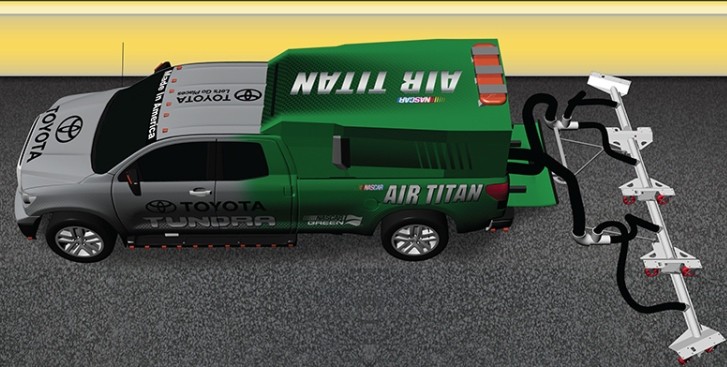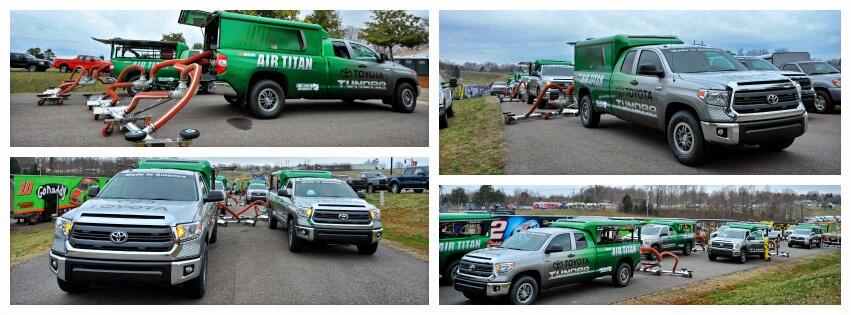What’s the biggest enemy of motorsport? New fuel consumption regulations and smaller engines? Neah, as long as there are spinning wheels racing will go further no matter what. The correct answer here is rain. How many time you went to race and it got interrupted or even canceled due to rainfall? Probably a lot.
Although from the side, some water on the track doesn’t look that scary, there’s a whole other version of the story if you take the seat behind the wheel. There are two main problems water on the track causes - less visibility, because the cars in front will raise it up into the air in a fine mist, and most importantly, lowered tire grip.
However, if in the majority of races people just wait for the track to dry up a bit before letting the cars run again, in NASCAR people don’t have time fo’ dat. So last year, NASCAR Research and Development Center in Concord came with the Air Titan last year. This is basically a V8 engine mounted in the bed of a pickup truck that powers a big compressor. The stored compressed air then gets to hit the asphalt via multiple nozzles also aided by a support vehicle, driving the water out the way and leaving the track dry.
And this year, the system already got an improved version, as NASCAR revealed the Air Titan 2.0 today at Martinsville. The new system can now fit in just a single vehicle, in this case a Toyota Tundra. This way, NASCAR is able to deploy upt to 21 units at larger venues and operate more efficiently on smaller tracks.
“The Air Titan 2.0 is the latest example of NASCAR making substantive changes to our operations and business practices to help reduce the environmental impact of our sport,” said Dr. Mike Lynch, NASCAR vice president of green innovation. “We welcome Elgin to the consortium of more than 20 Official NASCAR Green Partners that utilize the platform as a proving ground to validate its green technologies.”
The Air Titan 2.0 also comes with quite some interesting specs now:
However, if in the majority of races people just wait for the track to dry up a bit before letting the cars run again, in NASCAR people don’t have time fo’ dat. So last year, NASCAR Research and Development Center in Concord came with the Air Titan last year. This is basically a V8 engine mounted in the bed of a pickup truck that powers a big compressor. The stored compressed air then gets to hit the asphalt via multiple nozzles also aided by a support vehicle, driving the water out the way and leaving the track dry.
And this year, the system already got an improved version, as NASCAR revealed the Air Titan 2.0 today at Martinsville. The new system can now fit in just a single vehicle, in this case a Toyota Tundra. This way, NASCAR is able to deploy upt to 21 units at larger venues and operate more efficiently on smaller tracks.
“The Air Titan 2.0 is the latest example of NASCAR making substantive changes to our operations and business practices to help reduce the environmental impact of our sport,” said Dr. Mike Lynch, NASCAR vice president of green innovation. “We welcome Elgin to the consortium of more than 20 Official NASCAR Green Partners that utilize the platform as a proving ground to validate its green technologies.”
The Air Titan 2.0 also comes with quite some interesting specs now:
- Delivers air at a speed of 568 mph
- Raises air temperature by 70 degrees over ambient at the blade
- Could fill the Goodyear Blimp in 3.4 minutes
- Could dry a football field in 20.5 seconds
- It has more than three times the blade capacity of the first AirTitan
- Consumes 78 percent less fuel per hour
- Emits 80 percent less CO2 per hour
- Reduces drying time by 25-50 percent depending atmospheric conditions

